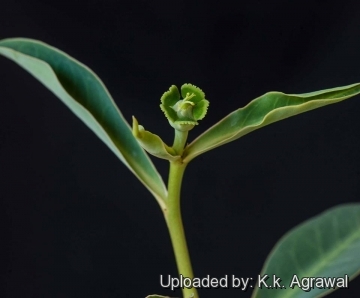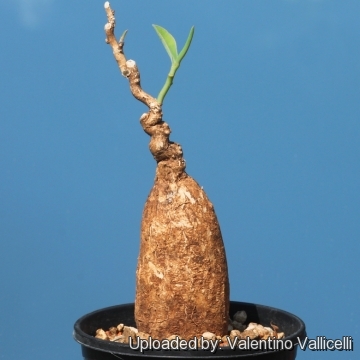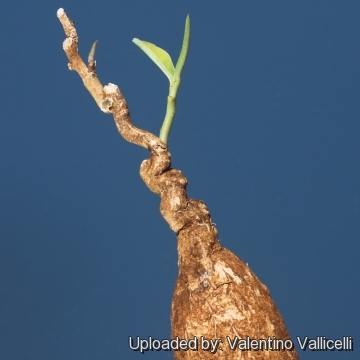
Euphorbia maritae Photo by: K.k. Agrawal
Origin and Habitat: Tanzania, Morogoro district. Only known from the type collected in 1999.
Altitude: About 500 m
Habitat: It grows in open savannah on laterite (a soil rich in iron and aluminium, formed in hot and wet tropical areas and rusty-red because of iron oxides)
Synonyms:
Description: Euphorbia maritae is a perennial herb with a round tuber, related to Euphorbia platycephala and very similar to Euphorbia eranthes.
Root (tuberous rootstock): Deeply buried in the soil, round to somewhat elongated 4-10 cm in diameter and up to 20(-25) cm tall covered by a yellowish brown cork, but often raised for aesthetic reason in cultivation.
Stem: Usually unbranched, mostly underground about 1 cm thick, up to 20 cm long, contorted and notched with a thin aerial part with leaves and flowers that rarely exceeds 6 cm of height, short living and deciduous.
Leaves: Very shortly petioled, somewhat succulent, elliptic up to 6,6 cm long and 3,5 cm wide.
Inflorescence: Cymes with few rayed umbels, 1-2 forked
Flowers: Green ciathia about 8 mm in diameter.
Fruit: 1,5 cm in diameter on a 2 mm long pedicel.
Seed: About 5 mm dark-brown.
Notes: This species produces an unusual effect owing to the tuberous root being planted well out of the soil.
 Euphorbia maritae Photo by: K.k. Agrawal
Euphorbia maritae Photo by: K.k. Agrawal Euphorbia maritae Photo by: Valentino Vallicelli
Euphorbia maritae Photo by: Valentino Vallicelli Euphorbia maritae Photo by: Valentino Vallicelli
Euphorbia maritae Photo by: Valentino VallicelliSend a photo of this plant.The gallery now contains thousands of pictures, however it is possible to do even more. We are, of course, seeking photos of species not yet shown in the gallery but not only that, we are also looking for better pictures than those already present.
Read More... Cultivation and Propagation: A very very light and warm place in full sun is highly appreciated. It does best in a mineral soil, good drainage is essential. Water sparingly during the summer months and keep dry in winter. When not in growth it is killed right away, when given too much water. It is a slow growing long lived plant and once established, it will be content in its position and with its soil for years. It can tolerate moderate shade, and a plant that has been growing in shade should be slowly hardened off before placing it in full sun as the plant will be severely scorched if moved too suddenly from shade into sun.
Frost Tolerance: Tender, it needs frost protection.
Propagation: It is propagated from seed sown during spring or summer. Germination occurs within 3 weeks.
Warning: As with all other Euphorbias when a plant get damaged it exudes a thick white milky sap known as latex. This latex is poisonous and particularly dangerous for the eyes, skin and mucous membranes. So pay extreme attention not to get any in your eyes or mouth. Cultivated plants must be handled carefully.













